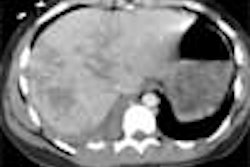CHICAGO - Renal masses are among the most common of incidental findings, and the increasing use of imaging in recent years has produced a fool's bounty of indeterminate lesions. Fortunately most are benign, and further evaluation is often reserved for masses 6 mm and larger.
Still, some solid and complex renal lesions look a lot like cancer, close enough to enhance with iodinated contrast at CT or gadolinium at MR. According to a new study based on the results of nephron-sparing surgery, however, many of these cancer look-alikes are actually benign.
Minimally invasive nephron-sparing surgery is increasingly being used to treat select patients with small renal tumors.
At Wednesday's genitourinary sessions of the RSNA meeting, Dr. Gaspar Motta-Ramirez from the Cleveland Clinic in Cleveland Heights, OH, said that as many as one-sixth of lesions with a solid or cystic appearance may be noncancerous.
"The simple purpose of our study was to determine whether small renal lesions are more likely to be benign," Motta-Ramirez said.
The retrospective study examined 616 renal lesions resected in 587 patients who underwent nephron-sparing surgery over three years, based on volume-rendered CT or MR images used for surgical planning. Thirty-two lesions were excluded because of demonstrable fat (determined to be angiomyolipoma at CT), nontransitional cell carcinoma, or lack of pathological proof of findings, leaving a total of 584 lesions in 570 patients.
Histologically proven pathology was determined from the medical records, and lesion size was recorded from the CT or MR findings, and grouped into three sizes for analysis: smaller than 4 cm, larger than 4 cm, or larger than 7 cm, Motta-Ramirez said. Nephron-sparing surgery was reserved for patients with lesions 4 cm and smaller, but the presurgical planning found a wider range of sizes.
"Of all the cases, 103 were benign lesions and 481 were malignant lesions," he said, displaying a series of images that underscored the difficulty of discerning benign from malignant lesions at both MR and CT imaging. Two similar images showed solid lesions of the posterior kidney that were interpreted as renal cell carcinomas after they enhanced with gadolinium in MR. But only one diagnosis was correct. Histology following resection showed the second lesion was an angiomyoma. Next, two similar-appearing small solid lesions enhanced following administration of IV contrast in CT were shown. At histology one was a small renal cell carcinoma and the other an oncocytoma, Motta-Ramirez said.
Of 390 lesions 4 cm and smaller, 72 were benign, 318 (81.5%) were found to be malignant, including 50 oncocytomas, 10 angiomyolipomas without fat at CT, 14 benign cysts, and 163 cystic masses. Sixteen percent of the findings were benign among 188 lesions larger than 4 cm, including 13 oncocytomas, three angiomyolipomas without fat, and 14 cysts.
Overall 84.5% lesions were malignant and 15.5% were benign. Lesion size was not a statistically significant predictor of benign lesions. Again comparing both size groups, 12.8% of all lesions 4 cm or smaller and 6.7% of those larger than 4 cm were oncocytomas, Motta-Ramirez said. There was a trend toward more oncocytomas in the smaller lesions, but it did not reach statistical significance (p = 0.06), he said. Lesion size did not otherwise predict benign lesions of any kind (p > 0.169).
As for limitations, the Cleveland Clinic Foundation's specialization in nephron-sparing surgery may have led to higher percentages of patients with smaller lesions, and may have favored higher rates of benignity, he said. Also, the investigators did not differentiate solid from cystic lesions.
"One-sixth of all renal lesions, whether small or large, were found to be benign," and 7% to13% of such lesions were oncocytomas, Motta-Ramirez said. "Based on these findings, surgeons should know that they will find benign lesions regardless of radiological appearance."
By Eric Barnes
AuntMinnie.com staff writer
December 2, 2004
Related Reading
US, MRI challenge CT for classifying renal cell carcinoma, June 17, 2003
Ultrasound effective in diagnosis, treatment of cystic liver lesions, May 15, 2003
Percutaneous radiofrequency ablation may be an option for solid renal masses, April 21, 2003
Radio-frequency ablation effective for many renal cell carcinomas, January 29, 2003
Imaging explores link between kidney failure and atherosclerosis, January 28, 2002
Copyright © 2004 AuntMinnie.com



















